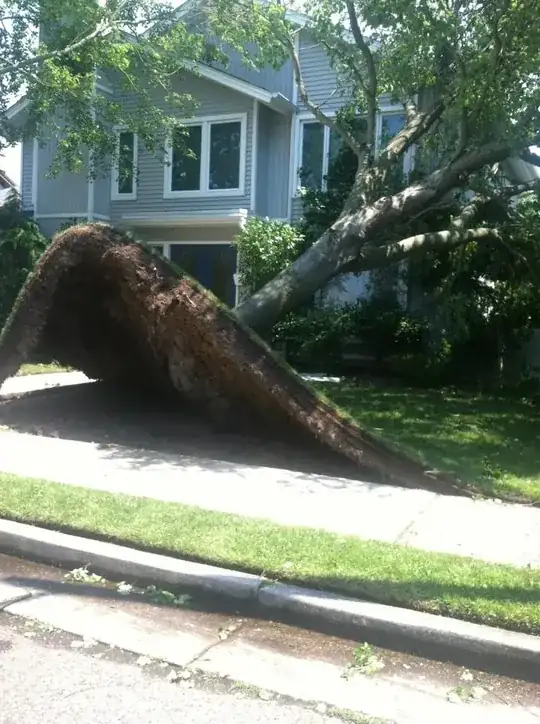It's probably very hard to tell simply by looking at a tree, that otherwise shows no obvious indications of being weak, but here are a few things to watch out for:
I would be very skeptical of a tree that is perfectly straight (yours seems to be that way). It is a pretty good indication that the person who planted it trained it to grow straight by staking it to a vertical pole/support for a very long time. While this might be aesthetically pleasing, it does not allow the tree's stem to develop it's own bending strength. So when you have heavy winds, instead of the stem swaying and absorbing the force, the tree remains very stiff and eventually either snaps or transfers all the bending moment from the wind to the roots, which eventually give in.
If your tree has a sharp Y crotch (with the upper limbs very vertical), consult an arborist and cut the weaker one off. If you don't, they'll eventually break and cause damage in heavy winds/storm.
Stay clear of Bradford pears if you're in a windy/stormy area. They're notorious for breaking under winds/snow/storm (primarily because of point 2 above), yet people plant them because they look pretty. If you find them in a house that you bought in a windy area, better cut them down.
As pointed out by bstpierre, if you have a small woodlot (or just several trees surrounded by other trees) and you clear the peripheral trees or thin them down for whatever reason, you'll be exposing the inner trees to the winds. These are most likely going to be weaker, as they grew up being partially protected from the wind and now that there are't as many outer trees to break the wind, these are at risk of getting uprooted.
These are some of the visual indicators that you can use to identify. However, the bigger culprit lies underground, which is very hard to correct once the tree is established. If the root system is not well developed or shallow, then it will easily be blown over in a mild storm.
A lot of these problems have to do with improper care for the trees when they're young. Here are some things to keep in mind when you plant a new tree, so that you won't have problems 5–10 years later:
It might not be a bad idea to stake young saplings in regions with heavy winds so that don't get blown away. However, do not use a stiff vertical stake and train it upright. There are alternate ways of staking that provides support while at the same time, allows it to sway. See the answers to this question for more info on this.
Water less often, but water deep. Often people water their saplings every day/every other day in a shallow manner. By that, I mean watering just enough to wet the surface and maybe half an inch into the soil. This will result in the trees developing shallow root systems, because that's where the roots can find water. Instead you need to water maybe twice a week at most, but water deep so that the roots grow downwards in search of water. See the answers to this question (and is a standard advice in several answers scattered around).
Keep the height low by crown pruning. You can keep it as low as you think looks good, but I wouldn't let it get higher than 20 ft. This way, the winds won't have the same effect that it does on a taller tree. If anything happens, you're restricting the damage to just a 20 ft radius, and if you're careful to plant it 20 ft away from the house to begin with, you can also minimize potential damage. See the answer to this question for more information on crown reduction.
However, as Kevinsky mentions below, crown reduction is not a viable solution for evergreens as they just grow a new leader or multiple leaders with weak attachment points.
UPDATE:
I just saw this picture on reddit showing a tree that got uprooted in the recent storms in the US. This clearly illustrates my point above about shallow root systems being an easy prey for strong winds.
In today's "model" homes with quick-n-dirty landscaping, the builders more often than not, top off with a foot of soil with a hard gravel/clay/cement base underneath. While this might be fine for most plants, you should not plant trees here. In this case, the tree grew shallow roots that spread through the lawn because it could not go any further down (possibly hard base). Besides, having a lawn also ensured adequate shallow water supply which mean it didn't have to try to grow downwards either.


